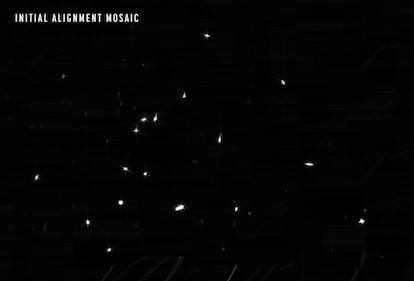The James Webb opens its eyes for the very first time (and also sends a selfie)
The NASA space telescope has transmitted its inaugural images, taken with the aim of starting to correctly align its 18 mirrors

The James Webb Space Telescope has begun the laborious process of calibration, and has already transmitted its first image. Well, in actual fact, its first 1,560 images, because that was the number of photos needed to determine the state of the 18 hexagonal mirrors that make up the main mirror.
As had already been announced, the positioning of these 18 reflectors is not yet perfect. The tremors from its launch and the thermal contractions due to its progressive reduction in temperature have caused each reflector to point slightly out of line with the rest. They will now move one by one in order to create a single surface that is as perfect as possible. For now, the Webb is not functioning like a single telescope, but rather 18 different ones, each of them sending its own image.
To do this, it first focuses on a bright star that cannot be confused with others around it. For this task, the rather prosaically named HD84406 has been chosen. It is located in Ursa Major, an area that is short on bright stars.
As was expected, the first photos taken with the telescope showed not one, but 18 bright points – i.e. the same star seen from 18 mirrors. The telescope took hundreds of photos to determine where HD84406 was, over an area not much bigger than the size of the Full Moon. Luckily, the images were closely grouped together, which says a lot about the quality of the telescope’s structure, given that it resisted the vibrations and acceleration of launch very well.
The next step involved identifying which image corresponded to each reflector. One by one, the technicians inclined each mirror by nanometers to discover the only point that had moved in a new photo. The identification took several hours. Now it is clear which is which.
Based on this information, the next step consists of adjusting the position of each mirror with microscopic movements. To do so, actuators that can move in steps that are 10,000 times smaller than the diameter of a human hair are used. And they do so without any lubrication and at temperatures of -230ºC.
They do this using precision motors and gears, but at first glance do not look particularly special. The secret lies in a very rigid H-shaped titanium part and another part that presses its central bar. As a result, the two lateral supports flex imperceptibly and that movement – of just a few nanometers – is transmitted to the mirror to get it into position.

This is one of the many ingenious solutions that had to be developed for this project, which aims to usher in a new era in astronomy, by providing information about the earliest stages of the universe, how stars were formed, and whether or not planets that lie far beyond our Solar System could support life.
Another example of problem-solving for the project is the fact that all of the mirrors have another driver in the middle that allows for their curvature to be changed in order to adapt it to the correct position. This technique of deformable mirrors was developed during the years of the Cold War, to compensate for atmospheric turbulence and thus allowing for photos to be taken from the ground of enemy military satellites. Today, they are used in most of the large observatories where telescopes can now – sometimes – compete with the quality of images that are sent from the Hubble Space Telescope.
Another of the images that the new telescope has already sent is a selfie in which its own mirror is visible. This was aimed at checking that the deployment had gone well and that all of the segments were fixed in position. By chance, one of them was pointed exactly toward the star, and its out-of-focus shine can be seen saturating the whole surface. The other 17 reflectors are in the shade, illuminated only by the glancing rays of the stars.
Tu suscripción se está usando en otro dispositivo
¿Quieres añadir otro usuario a tu suscripción?
Si continúas leyendo en este dispositivo, no se podrá leer en el otro.
FlechaTu suscripción se está usando en otro dispositivo y solo puedes acceder a EL PAÍS desde un dispositivo a la vez.
Si quieres compartir tu cuenta, cambia tu suscripción a la modalidad Premium, así podrás añadir otro usuario. Cada uno accederá con su propia cuenta de email, lo que os permitirá personalizar vuestra experiencia en EL PAÍS.
¿Tienes una suscripción de empresa? Accede aquí para contratar más cuentas.
En el caso de no saber quién está usando tu cuenta, te recomendamos cambiar tu contraseña aquí.
Si decides continuar compartiendo tu cuenta, este mensaje se mostrará en tu dispositivo y en el de la otra persona que está usando tu cuenta de forma indefinida, afectando a tu experiencia de lectura. Puedes consultar aquí los términos y condiciones de la suscripción digital.
More information
Últimas noticias
The late consecration of women artists in their 90s
The Florida Keys tourist paradise is besieged by immigration agents: ‘We’ve never seen anything like this’
The latest scam on WhatsApp behind the legal dream: using immigration status as bait
Oil, gold and rare earth elements: the backdrop to US political tension with Venezuela
Most viewed
- Families demand repatriation of bodies of Colombians who died in Ukraine: ‘This war is a slaughterhouse for foreigners’
- The low-cost creative revolution: How technology is making art accessible to everyone
- Liset Menéndez de la Prida, neuroscientist: ‘It’s not normal to constantly seek pleasure; it’s important to be bored, to be calm’
- Christian Louboutin: ‘Young people don’t want to be like their parents. And if their parents wear sneakers, they’re going to look for something else’
- ‘El Limones’ and the growing union disguise of Mexican organized crime











































